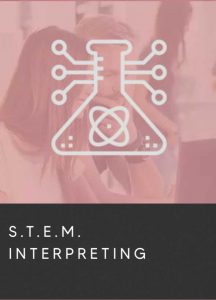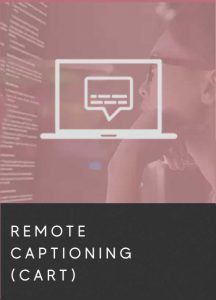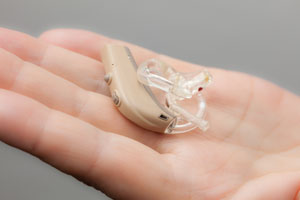 American Sign Language Interpreting is a profession like no other! Each day and each assignment is vastly different, offering the ability to learn and see things from a new perspective. This field attracts a certain type of individual with a deep passion for communication and developing relationships. But more than that: ASL interpreters must be gracious friends and fierce allies of the Deaf community that welcomes us into their lives.
American Sign Language Interpreting is a profession like no other! Each day and each assignment is vastly different, offering the ability to learn and see things from a new perspective. This field attracts a certain type of individual with a deep passion for communication and developing relationships. But more than that: ASL interpreters must be gracious friends and fierce allies of the Deaf community that welcomes us into their lives.
Interpreters have the unique opportunity to share in a wide range of unscripted personal experiences. From job interviews to family reunions; from business meetings to parent teacher conferences, we are granted access to the lives of deaf consumers and this is a responsibility that should never be taken lightly. These relationships are the human element of interpreting that assist in bridging the cultural gap.

In service to the Deaf community, ASL interpreters are invited into this diverse culture that has no racial, religious, or ethnic barriers. It is distinctly American, yet has its own heritage and set of social customs, such as the long-lasting phenomenon known as the “Deaf goodbye” or assigning people their Name Sign. Interpreters who can hear must be willing to become a minority within the Deaf community, we must be able to step back from our privilege to assume a new identity as mediator (or bridge) between the deaf and hearing worlds.
What inspires a person to become a sign language interpreter? Some are motivated by their deaf family members or friends. These people already use ASL and they have seen firsthand the prejudice and barriers that exist within our society. Others enter this field driven by their fascination with languages, cultures, and community. No matter what brings a person to this profession, we all share a common desire to assist in creating connections and uplifting the Deaf population. When we see effective communication happening, it’s a truly fulfilling experience.

ASL interpreting is a career that requires continuous growth, it attracts people who are prepared to engage in lifelong personal and professional development. As interpreters, there are such a wide variety of scenarios we can work in once we have the qualifications and experience.
Everyone has their own “specialty” area, “favorite” setting, and a type of situation they “would love to” interpret for. For example: my “specialty” is educational interpreting, having worked in a college environment for more than 6 years. My “favorite” setting is business interpreting, where I have the opportunity to assist in making connections within companies and organizations to ensure the deaf consumers’ success. And the scenario I “love to” interpret for is behind the scenes on film and television sets, here I get to help facilitate higher visibility for Deaf talent within the entertainment industry.
Taking on different roles allows interpreters to take a microscope to all these different parts of society. We are granted access to people’s everyday lives, and to be effective we must come to understand the situations that Deaf consumers find themselves in.
 To create effective communication, a Business interpreter will endeavor to understand the ethics of the company and the power dynamics between each person involved. When working in a mental health setting, an interpreter must really have a thorough understanding of the healthcare profession and the patient, and they will take an active interest in the long term treatment plan for the individual. When providing ASL services for a play or musical, interpreters will immerse themselves in the piece, yes, but they also must come to know the character as portrayed by the performer. For religious ceremonies, interpreters are invited to take part in deeply held traditions, which requires reverence and respect. Interpreters who work family events play an important role in creating cherished memories– I’ve personally witnessed deeper connections and more meaningful relationships being formed within my own family thanks to the interpreters who join us for events and holidays. Interpreters who work in medical settings assume responsibility for accurately conveying critical, complex, and highly specialized information between deaf and hearing parties. This is why ongoing relationships between interpreters and consumers can be beneficial for everyone involved.
To create effective communication, a Business interpreter will endeavor to understand the ethics of the company and the power dynamics between each person involved. When working in a mental health setting, an interpreter must really have a thorough understanding of the healthcare profession and the patient, and they will take an active interest in the long term treatment plan for the individual. When providing ASL services for a play or musical, interpreters will immerse themselves in the piece, yes, but they also must come to know the character as portrayed by the performer. For religious ceremonies, interpreters are invited to take part in deeply held traditions, which requires reverence and respect. Interpreters who work family events play an important role in creating cherished memories– I’ve personally witnessed deeper connections and more meaningful relationships being formed within my own family thanks to the interpreters who join us for events and holidays. Interpreters who work in medical settings assume responsibility for accurately conveying critical, complex, and highly specialized information between deaf and hearing parties. This is why ongoing relationships between interpreters and consumers can be beneficial for everyone involved.

Besides offering ample opportunity for growth, sign language interpreting is a career that can take one all around the world. Deaf people travel for both work and enjoyment, and they often ask interpreters to help facilitate communication in these everyday situations. A business executive might bring a certain interpreter with them when they travel because they feel that person accurately represents them and their business. Interpreters who work for government officials are entrusted to faithfully maintain the personality of the deaf individual, and they get a rare insider perspective into the world of politics.
From weddings, to school plays, to kickboxing lessons; from births, to job promotions, to funerals— sign language interpreters stand beside the deaf community through life’s many ups and downs. I don’t think I am alone in believing that ASL interpreting is so much more than just a career. Between overnight emergency stays at the hospital with consumers, and the weekend-long professional development conferences, ASL interpreting becomes a way of life. Interpreter is an identity within Deaf culture, it is one that I wear proudly on Interpreter Appreciation Day (May 1) and every other day of the year!

















 American Sign Language Interpreting is a profession like no other! Each day and each assignment is vastly different, offering the ability to learn and see things from a new perspective. This field attracts a certain type of individual with a deep passion for communication and developing relationships. But more than that: ASL interpreters must be gracious friends and fierce allies of the Deaf community that welcomes us into their lives.
American Sign Language Interpreting is a profession like no other! Each day and each assignment is vastly different, offering the ability to learn and see things from a new perspective. This field attracts a certain type of individual with a deep passion for communication and developing relationships. But more than that: ASL interpreters must be gracious friends and fierce allies of the Deaf community that welcomes us into their lives.

 To create effective communication, a
To create effective communication, a 
 Imagine attending a business meeting where everyone around the table whispered to you, covering their mouths and mumbling their words. Picture the frustration you would experience at the end of the meeting when everyone left with their notes but you were left struggling to figure out what the discussion was even about. For deaf individuals who read lips, this situation plays itself out daily in both personal and professional settings.
Imagine attending a business meeting where everyone around the table whispered to you, covering their mouths and mumbling their words. Picture the frustration you would experience at the end of the meeting when everyone left with their notes but you were left struggling to figure out what the discussion was even about. For deaf individuals who read lips, this situation plays itself out daily in both personal and professional settings.
 Too often, I am contacted by people who are deaf who have been denied interpreters in the workplace or in schools, or in any setting, because the hearing people they approached about providing reasonable accommodation used their own judgment to decide that the deaf person’s lip reading skills would be sufficient. Communication is a human right and refusing it is a subtle form of oppression.
Too often, I am contacted by people who are deaf who have been denied interpreters in the workplace or in schools, or in any setting, because the hearing people they approached about providing reasonable accommodation used their own judgment to decide that the deaf person’s lip reading skills would be sufficient. Communication is a human right and refusing it is a subtle form of oppression.







